How Our B2B SaaS Fractional CMO Service Works (And How It’s Different From A Traditional CMO)
Last updated: August 23rd, 2024
There are two common scenarios we see among B2B SaaS companies who look for a Fractional CMO:
- They can afford a team for execution OR a full-time CMO, but not both.
- Their executive team (often including their CMO) wants an outside perspective to understand additional opportunities for growth.
We offer a fractional CMO service that’s crafted specifically for companies that want to increase growth and have the following qualities or characteristics:
- Their in-house staff are consumed with day-to-day marketing operations. They feel they lack the expert level guidance that would help them achieve more. Marketing feels tactical rather than strategic and holistic.
- They have a minimum of 3+ marketing team members who can handle execution.
- They’re doing $10M+ ARR with an annual contract value of $25K+.
What follows is an in-depth look at our Fractional CMO service for companies that meet the criteria above.
First, we’ll lay out how our service is different than other market offerings. Then, we’ll walk through the details of our service.
You’ll see an in-depth example of the monthly scorecards we use to help our clients benchmark and improve their results.
If you’d like to learn more about how we can help your B2B SaaS get more out of your marketing, reach out to get your Free Marketing Plan today.
If you prefer to listen to posts like this, you can subscribe to our podcast SaaS Marketing Bites. It’s available on all popular podcast platforms or you can listen right here:
How Our Fractional CMO Service Is Different: A Proven Methodology Plus a Team (vs. an Individual) to Guide You
There are two core ways in which we differ from other Fractional CMO services:
- We’ve developed and mapped out a holistic marketing framework for execution. It’s specifically designed to achieve predictable growth for trial and demo-based B2B SaaS companies.
- Because we’re an agency, instead of one high-level marketing leader advising you, you get support from a team of channel experts.
Before we dive into what our service entails, let’s look at these two points of difference more closely.
1. The Predictable Growth Methodology
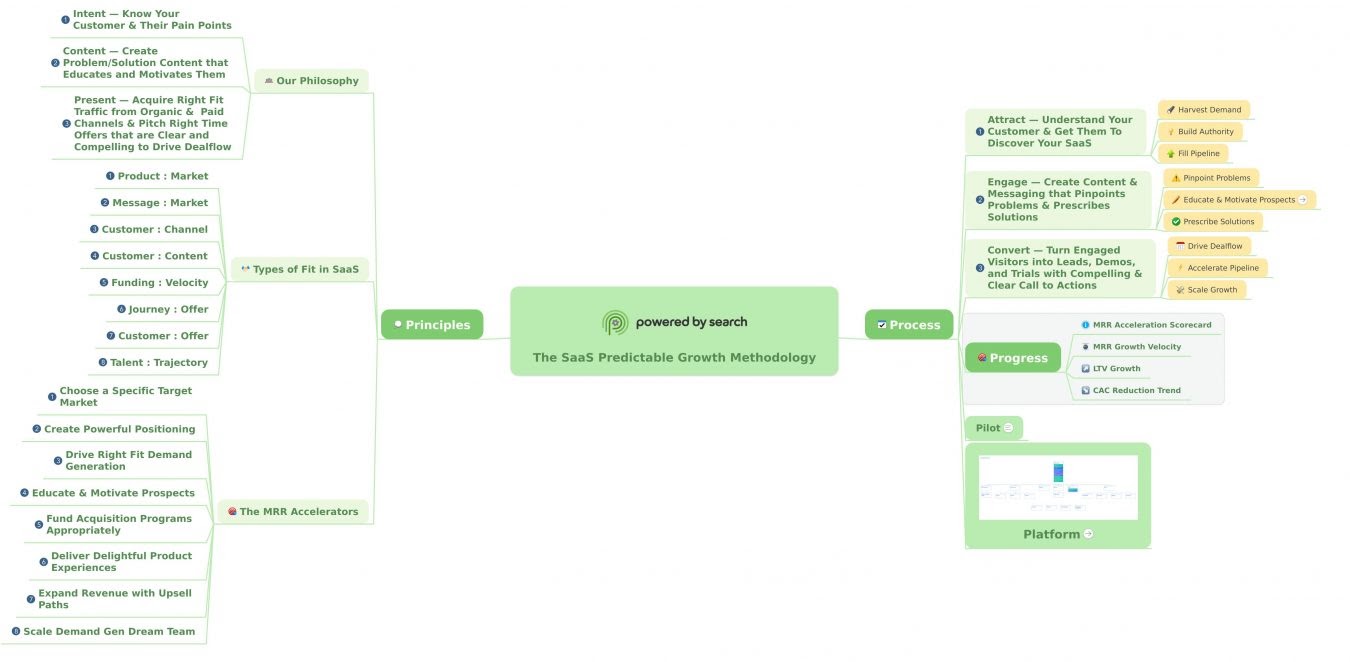
We’ve spent more than a decade working with SaaS and technology companies and have developed a detailed framework for helping our clients grow.
It helps us solve the number one problem that we see holding companies back: deploying a buffet of tactics without a well defined strategy.
We built our methodology on principles that can lead to predictable growth when followed.
Some of these key principles include:
- Customer-Channel Fit: Finding the optimal channels for turning prospects into customers.
- Customer-Content Fit: Understanding how to communicate your positioning through your content in a way that reduces friction on the path to signing up for a trial or demo.
- Journey-Offer Fit: Matching what you offer customers to their current place in the sales funnel.
And based on these principles, we’ve mapped out a holistic demand generation strategy, including SEO, PPC, email marketing, and more.
With this process laid out (the map pictured above), we have a tool to pinpoint where our clients are performing well and which areas they need to improve.
We’ve written several in-depth case studies about applying the method to demonstrate how it works.
You can see all of our SaaS marketing case studies in this resource, but here are a few that are likely most relevant to you:
- How Powered by Search Helped iWave Achieve a 7-Figure Revenue Growth from Paid Media in Under a Year
- How Powered by Search Helped Fortra Grow Right-Fit Enterprise SQLs by 15% Year-Over-Year
- How Powered by Search’s B2B SaaS Expertise Helped Collibra Exceed their Marketing Targets
2. Support from a Team, Not an Individual
Most fractional CMO services consist of one experienced marketing leader. That lone executive is then relied on to offer the same high-level guidance as an in-house CMO.
While they likely have a proven track record helping companies grow, your company’s growth is still limited to a single person’s expertise.
Unfortunately, a single person can’t be an expert in every marketing channel, and fractional CMOs are typically high-level strategists who can steer the ship but cannot offer guidance on the inner workings of strategy execution.
This can be problematic because the best marketing strategy won’t work if the campaigns within it are ineffective.
With our Fractional CMO service, you gain access to not only one expert strategist but a team of specialized marketers with deep knowledge of particular marketing channels, from PPC and email marketing to SEO and digital PR.
By pairing leadership with channel experts intimately versed in day-to-day execution, we can deliver more value than a single strategic consultant.
Additionally, each of our team members has worked with dozens of B2B SaaS companies similar to yours, so you also benefit from their compounding knowledge rather than relying on the experience of a single individual.
3. Emphasize Action Over Advice
It’s not uncommon for companies to hire a fractional CMO, develop an effective marketing strategy, and then fail to execute the plan.
Unfortunately, if the strategy is poorly executed or behind schedule, you still won’t hit key targets.
Execution issues usually arise because the team needs more accountability and support to navigate roadblocks.
To solve this, we’ve structured our Fractional CMO service to emphasize action.
Specifically, we use a scorecard to set biweekly goals with your team to ensure the strategy is on track to meet quarterly and annual revenue targets.
To hold the team accountable, we hop on a biweekly call and work through challenges as they arise. If there are roadblocks with specific campaigns, we can pull in individual experts from our team to identify and solve challenges.
By incorporating two-week sprints into our Fractional CMO service offering, we can ensure the team has the support and accountability necessary to execute the strategy and resolve issues before they hinder growth.
Our Fractional CMO Service, Explained
Below we’ll discuss the details of our Fractional CMO service, but here’s a high level overview:
- Identifying critical revenue targets.
- Mapping a strategy with specific biweekly goals to achieve those targets.
- Two-week sprints to ensure strategy execution is on track.
Before beginning an engagement, we establish specific outcomes and revenue targets you wish to achieve.
From there, we’ll audit your current performance, identify opportunities, and work with your team to establish the Key Performance Actions necessary to meet your goals.
To guide each two-week sprint, we use scorecards to track specific metrics and ensure the team makes the necessary incremental progress to reach the end goals.
For example, if you wanted to improve your SEO results, we might create a scorecard that measures your capacity in:
- Technical site health
- Content quality
- Backlinks
- Keyword rankings
- Organic traffic
- Organic conversions
Note: The subcategories and content of a scorecard are always strategically chosen based on each clients’ specific context and goals.
After establishing biweekly targets, we collaborate with the team to divide tasks and ensure everyone is clear on expectations.
We’ve found that two-week sprints are ideal as they provide enough time for the team to make meaningful progress, yet not so much time that the strategy falls behind if any area of the execution falters.
At the end of each two week sprint, we hop on a 30-60 minute call to discuss wins, identify and resolve bottlenecks, and establish action items.
On our side, we make sure the right experts from our team are on each call (e.g., if you’re doubling down on PPC and SEO, we make sure our PPC and SEO experts are on the call).
This way, you can always access the support necessary to fix strategic and technical issues within specific campaigns.
Additionally, each team member reviews progress before each call and comes prepared with observations and feedback to ensure each session is productive and helpful.
During the alternating weeks when there isn’t a scheduled call, we’ll review your team’s progress via Loom videos and provide feedback via our own Loom videos to create a rapid feedback loop.
This additional touchpoint is another way we ensure your team has the accountability and support necessary to take action.
The Processes We Use To Guide Our Fractional CMO Service
The key to any successful marketing strategy is systems and processes, and here are three of the tools we use to predictably drive results for clients with our fractional CMO offering.
Setting Revenue Driven Goals With The Marketing Funnel Forecast
Rather than looking at only 1 or 2 specific marketing channels, we analyze your full marketing funnel to understand where opportunities exist and map out a holistic demand generation strategy.
Therefore, the first step of any engagement is creating a marketing funnel forecast. This data allows us to understand key marketing, sales, and revenue metrics that will guide the marketing strategy and allow us to accurately understand how our marketing efforts impact revenue.

This approach allows us to attribute revenue to marketing efforts and quickly identify and address bottlenecks.
How Our Scorecards To Map Actions To Goals
The scorecard is a core element that drives the two-week sprints.
We create scorecards for each marketing channel (SEO, PPC, etc.) and use them to track specific metrics for that channel.
For example, we might create a PPC scorecard and track specific metrics around budgeting and messaging. We give each of these metrics a numerical score and color code it (red, green, and yellow) to make it easy to get a quick snapshot of each marketing channel’s current status and progress.
To illustrate how we use scorecards, here’s an example of a PPC scorecard we implemented for a client who needed help improving their Google Ads and Facebook Ads.
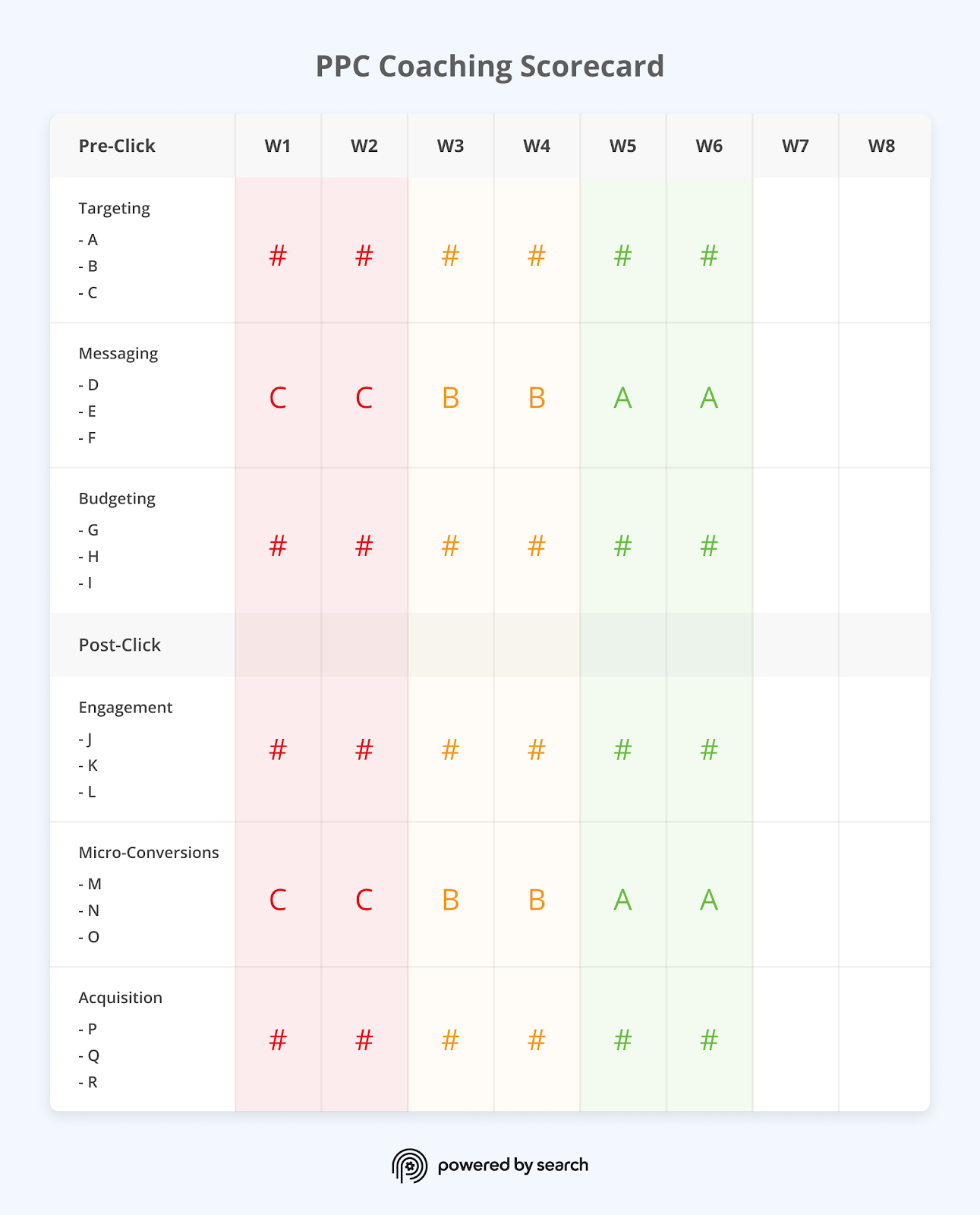
In our audit, we discovered their main focus centered around pre-click elements of their PPC funnel. These were things like targeting, messaging, and budgeting. What they missed were their funnel’s post-click elements such as landing page engagement and conversions.
Because of this, they could’ve been doing everything correctly (like getting great click through rates, costs per click, etc.), but still falling short on converting landing page visitors into MQL’s and SQL’s.
So we set up a scorecard for them to benchmark key subcategories of the pre and post-click performance of their PPC campaigns.
In contrast to audits or roadmaps that dig into unnecessary minutia, the key to our scorecards is that they’re built to prioritize effort and impact.
For both pre-click and post-click, we chose three categories where our clients had the most to gain relative to their current performance. We then identified three metrics in each of those categories to grade and track progress on.
We use red, yellow, and green color coding to signify the grade or numerical score of each metric. Red-coded metrics are elements their in-house teams must focus on first. Getting all those scorecard metrics to green is the equivalent of getting an “A” grade in school.
In this case, we chose targeting, messaging, and budgeting as the pre-click categories of the scorecard. Meanwhile, we chose engagement, micro conversions, and acquisition as the post-click categories.
For each, we chose to benchmark, track, and improve the following three metrics:
Targeting
- Demographics, Interests, Behavior: A qualitative measurement of how well they’ve structured their core audiences for reaching new prospects.
- Retargeting: A measurement of how effectively they’re re-engaging people familiar with their business online. This might include people who have visited their website or previously downloaded a lead magnet.
- Lookalike Audiences: An assessment of how well they’ve structured their Facebook Lookalike audiences. This includes an assessment of what lists they’ve used to build them and what percentage they’ve chosen for targeting (1%, 2%, 5%, etc.).
Messaging
- Headlines: A qualitative assessment of how well their headlines engage visitors and communicate their positioning.
- Subheadlines: A qualitative assessment of how well their subheadlines communicate the “pros without cons” of their product. In other words, whether they communicate how their product solves a specific problem for their target audience.
- Calls to Action: A qualitative assessment of the copy, design, and placement of their CTAs — as well as how many they use on their landing page.
Budgeting
- Impression Share Loss Due to Budget: A metric to measure whether they’re appropriately budgeting, or whether they’re losing significant impressions due to under-funding.
- Budget to CPA Ratio: A measurement of whether they’re allocating enough budget in relation to their target cost per acquisition. Typically, we want this to be around 5:1 in order to get an adequate number of impressions for a campaign.
- Wasted Ad Spend: The number of search queries that yielded zero conversions and how much money was spent on them.
Engagement
- Bounce Rate: A metric to measure the percentage of people who visit their landing page and leave without taking any further actions.
- Scroll Depth: A measurement of how far down visitors scroll on their landing page.
- Interaction Events: A measurement of actions that visitors take on their pages such as watching their explainer video or clicking through their testimonial slider.
Micro Conversions
- Purchase Path Visits: A measurement of how many visitors move from their landing page to view their product or pricing pages. This is a good indicator of buying intent.
- Educational Material Interaction: A measurement of how many visitors view blog or resource pages.
- MQL Opt-In: A metric to view how many visitors opt in to download their lead magnet or sign up for their email list.
Acquisition
- Trial or Demo Signups: The number of visitors who fill out a form to begin a free trial or schedule a demo.
- Trial Activations or Demos: The number of visitors who filled out a form and then actually activated their trial by signing in or attending their scheduled demo.
- Trial or Demo Conversions: The number of trial users or demo attendees who become paying customers.
Our audit revealed that the team’s primary focus centered around pre-click elements of their PPC funnel, like targeting, messaging, and budgeting. However, they missed the funnel’s post-click elements, like landing page engagement and conversions.
As a result, their PPC strategy failed to drive sufficient MQLs and SQLs because, despite driving qualified traffic, they were failing to convert those visitors on the landing page.
How Our Scorecards Prioritize Impact
In contrast to audits or roadmaps that dig into unnecessary minutia, the key to our scorecards is that they’re built to prioritize low effort and high impact.
Here’s another example of a PPC scorecard we used to benchmark key subcategories of both the pre and post-click performance of a client’s PPC campaigns.
For both pre-click and post-click, we chose three categories where our clients had the most to gain relative to their current performance. We then identified three metrics in each of those categories to grade and track progress.
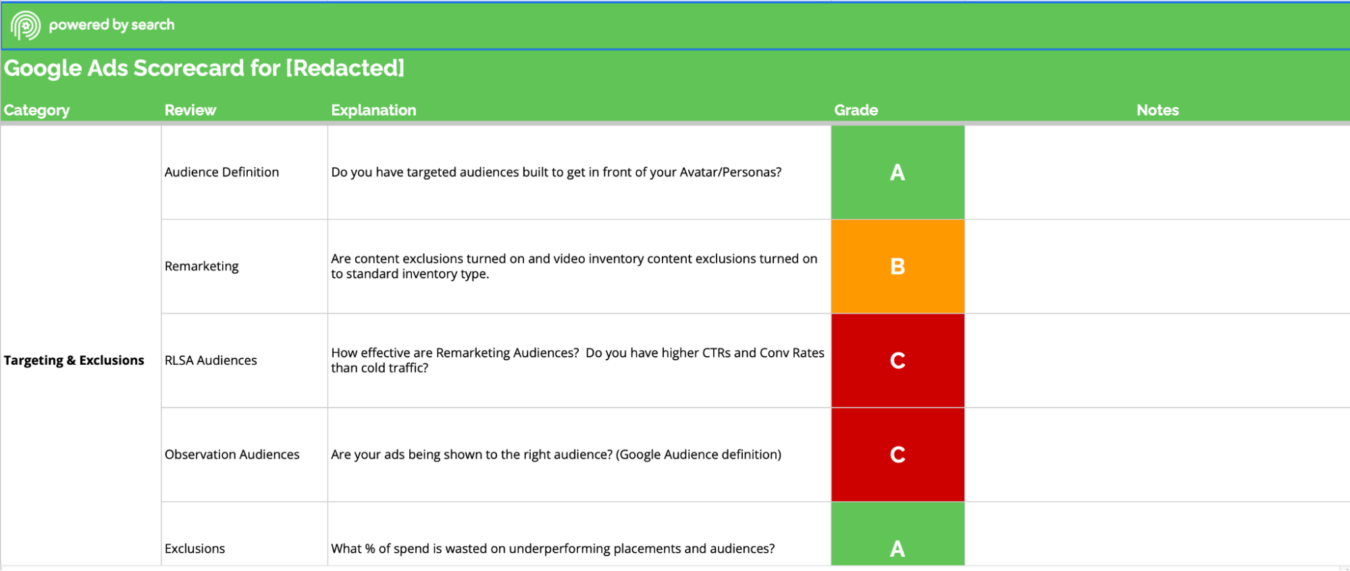
To give you an example of an SEO scorecard, here’s one we created for a client that tracks very specific metrics like bottom-funnel keyword gaps and mapping, on-page optimization and content depth, content refreshing, and other specific subcategories of SEO.
We also notate an explanation of each subcategory and provide insights and an impact rating. To track progress, you’ll also see a grade for that subcategory for each sprint:
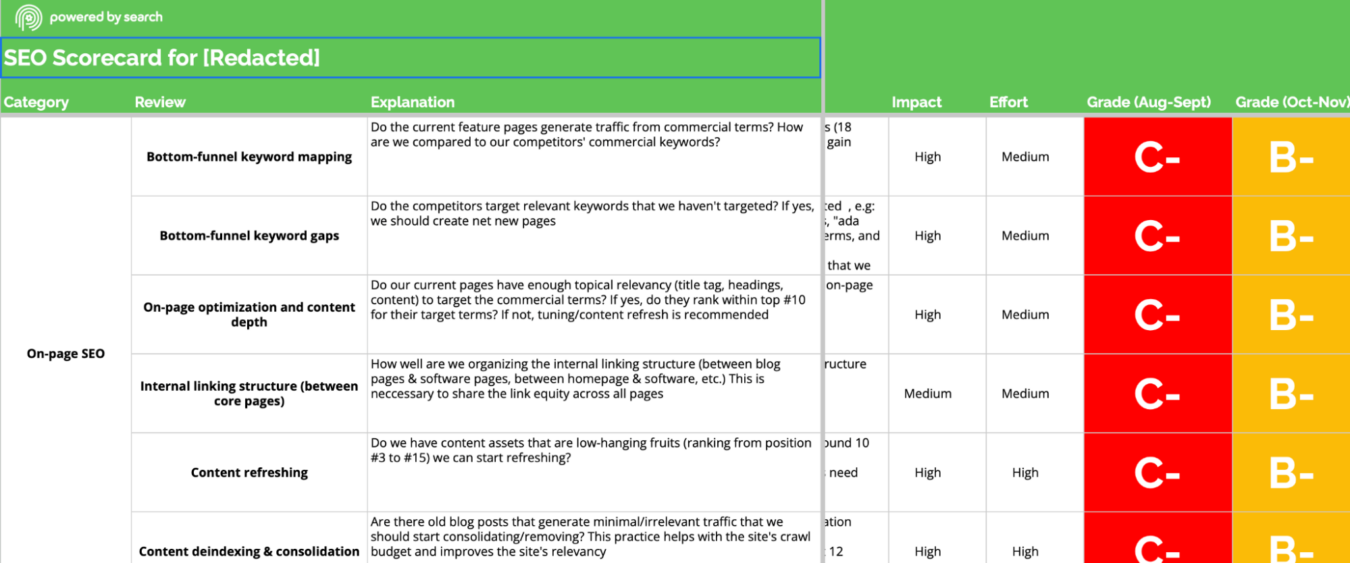
Our Hypothesis Log To Make Incremental Improvements
Most marketing teams run A/B tests, identify the winner, and make iterations of that variation.
Yet teams rarely record these tests, so they don’t have data or insights on what did or didn’t work in past campaigns. As a result, there’s a good chance they’ll inevitably run the same test twice.
To solve this problem, we use a hypothesis log to record each experiment we run and the insights learned from that test.
For example, if we run ads on two landing pages, we’ll record notes about the test we ran and specific insights, such as the copy and language that performed best.
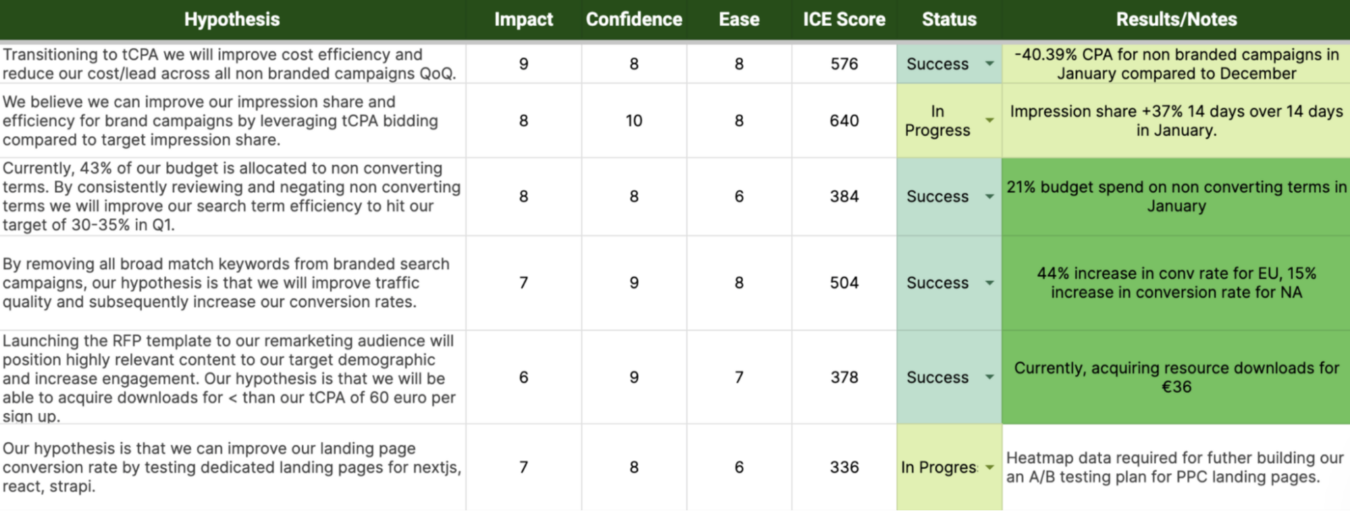
Then, we can implement what we learned from each test in all future marketing campaigns across various channels.
As a result, we accumulate a bank of data specific to your brand and target audience to make each consecutive marketing campaign more effective.
Ready to Level Up Your Growth with a Fractional CMO?
Even with the most advanced and competent in-house marketing teams, gaining outside perspective is a way to uncover the blind spots that limit your growth.
Yet we’ve found that relying on a single individual to steer your marketing team limits your team to that person’s systems, strategies, and experience. Most fractional CMO services also fail to provide executional support and accountability.
With our Fractional CMO service, you’ll gain access to a team of experts who are well versed in daily strategy and execution as well as proven tools and processes that effectively inspire action and track progress.
To recap, you’ll receive:
- An audit to benchmark your current performance in the area you wish to improve.
- A roadmap (updated quarterly) for improving your performance based on effort and impact.
- Weekly or bi-weekly coaching sessions to troubleshoot and guide your in-house team — complete with a custom scorecard for tracking performance.
To learn more about how Powered By Search can help your marketing team operate more efficiently, reach out to us today to learn more about our Fractional CMO service.
What you should do now
Whenever you’re ready…here are 4 ways we can help you grow your B2B software or technology business:
- Claim your Free Marketing Plan. If you’d like to work with us to turn your website into your best demo and trial acquisition platform, claim your FREE Marketing Plan. One of our growth experts will understand your current demand generation situation, and then suggest practical digital marketing strategies to hit your pipeline targets with certainty and predictability.
- If you’d like to learn the exact demand strategies we use for free, go to our blog or visit our resources section, where you can download guides, calculators, and templates we use for our most successful clients.
- If you’d like to work with other experts on our team or learn why we have off the charts team member satisfaction score, then see our Careers page.
- If you know another marketer who’d enjoy reading this page, share it with them via email, Linkedin, Twitter, or Facebook.